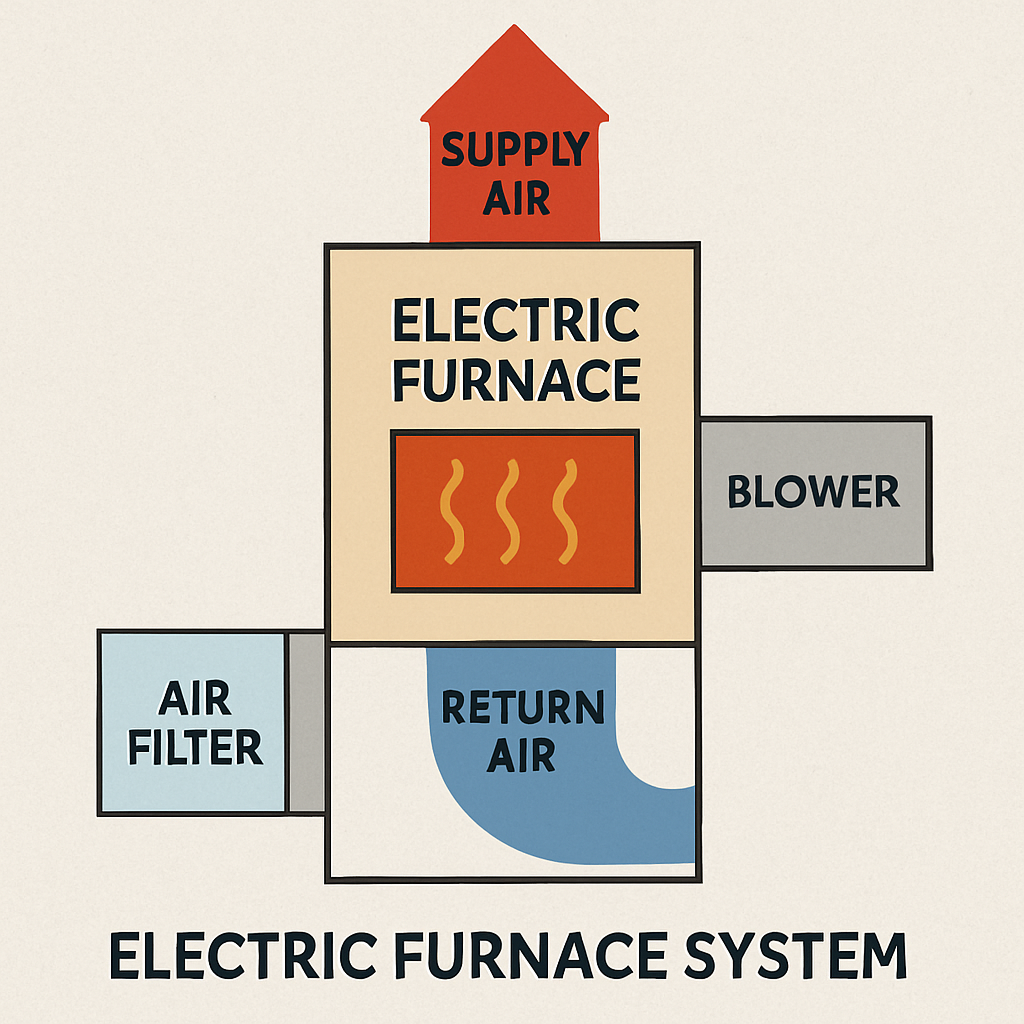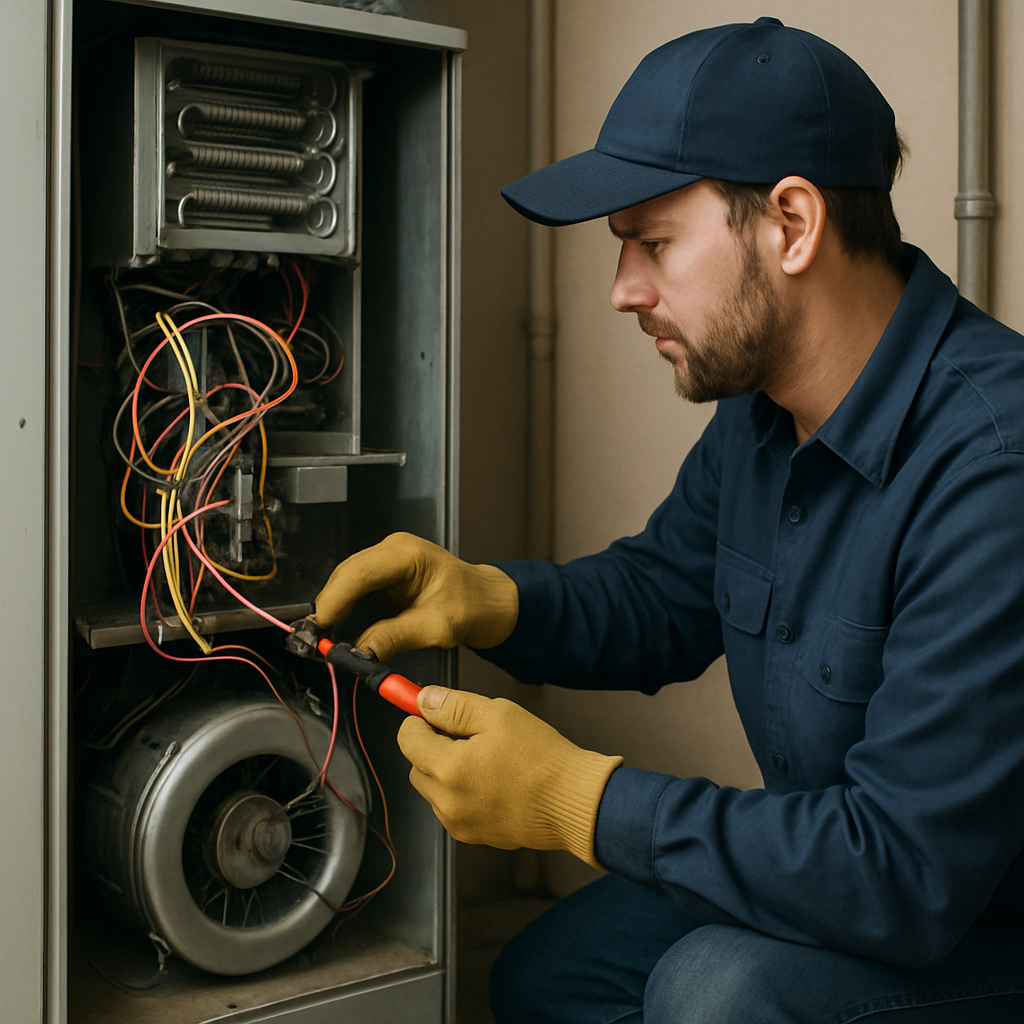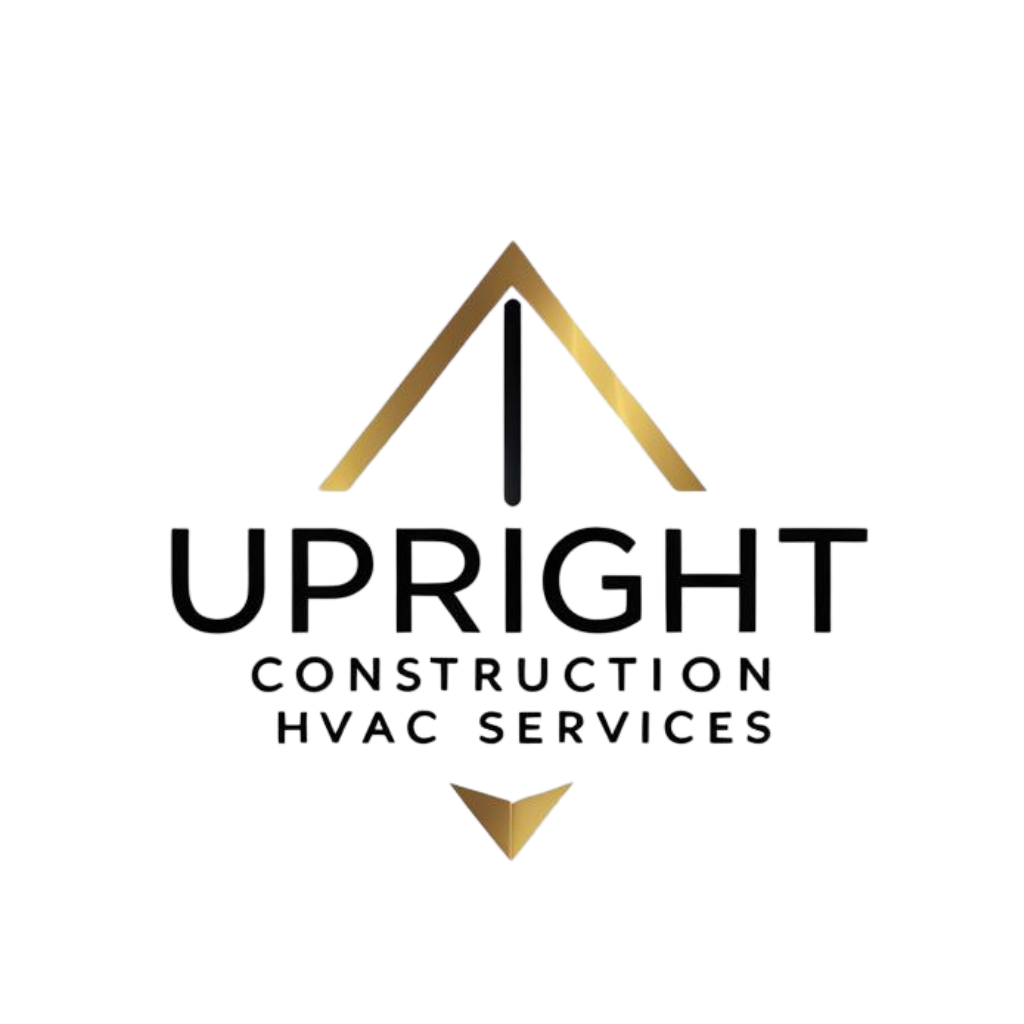- The Heating Process
- Key Components of an Electric Furnace
- Differences Between Electric and Gas Furnaces
- 1. Furnace Not Producing Heat
- Possible Causes:
- Solutions:
- 2. Insufficient Heat Production
- Possible Causes:
- Solutions:
- 3. Frequent Cycling On and Off
- Possible Causes:
- Solutions:
- Upflow Electric Furnace Models
- Common Issues:
- Horizontal Electric Furnace Models
- Key Considerations:
- Whole House Electric Heater Concerns
- Important Factors:
- Signs You Need Professional Help
- Why Choose UPRIGHT HVAC and Construction?
- Why is my electric furnace not producing any heat?
- The blower runs but the air is cold—what should I check?
- Why does my electric furnace keep tripping the breaker?
- What is a sequencer and how does it fail?
- What symptoms indicate a bad heating element?
- What causes short cycling (frequent on/off)?
- Are burning smells normal when the heat starts?
- Why is airflow weak from my vents?
- My furnace is noisy—what noises mean trouble?
- Which DIY checks are safe before calling a technician?
- Can the thermostat be the reason there’s no heat?
- Do electric furnaces have safety switches that stop heating?
- Why are my winter electric bills suddenly higher?
- How do I prevent common electric furnace issues?
- When is it urgent to shut the system off?
- What should a professional diagnostic include?
Los Angeles may be known for its sunny weather, but when the temperature dips, a reliable heating system becomes essential. For many homeowners, an electric furnace is the go-to solution for maintaining a comfortable indoor environment. However, like any appliance, electric furnaces can encounter issues over time. In this article, we will explore Troubleshooting Common Electric Furnace Issues and offer practical solutions to keep your home warm and cozy. At UPRIGHT HVAC and Construction, we’re dedicated to delivering high-quality service and ensuring your system operates efficiently.

Before diving into troubleshooting, it’s crucial to understand how an electric furnace functions. Unlike gas furnaces, electric furnaces use electrical resistance to generate heat. The process involves air being drawn into the furnace, passing over electric heating elements, and then being distributed throughout the home via ducts.
The Heating Process
The heating process in an electric furnace is a fascinating orchestration of components working in harmony. The journey begins when cool air is drawn into the furnace from your home’s interior. This air then travels over the electric heating elements, which are designed to convert electrical energy into heat through resistance. The heated air is then propelled into your home via a network of ducts, ensuring a uniform distribution of warmth.
Key Components of an Electric Furnace
- Heating Elements: These are responsible for generating heat through electrical resistance. Comprised of metal coils, they efficiently convert electrical energy into heat, which is then used to warm the air.
- Blower Motor: This component pushes the heated air through the ducts. It plays a pivotal role in ensuring that the heated air reaches every corner of your home, maintaining an even temperature throughout.
- Thermostat: Controls the furnace’s operation by signaling when to start and stop heating. It acts as the command center for your heating system, ensuring your home stays at your desired temperature.
- Limit Switch: Prevents the furnace from overheating by turning off the heating elements if the temperature becomes too high. This safety feature is crucial in preventing potential damage to the furnace or even fire hazards.
Differences Between Electric and Gas Furnaces
Electric and gas furnaces have distinct operational differences that affect their maintenance and troubleshooting. Electric furnaces rely on electrical resistance, which means no combustion occurs, reducing risks related to gas leaks. They often require less maintenance than gas furnaces, which have components like burners and pilot lights. Understanding these differences helps in diagnosing issues specific to electric furnaces and addressing them effectively.
Common Electric Furnace Issues and Solutions

Despite their reliability, electric furnaces can face issues that disrupt their efficiency and performance. Identifying these problems early can save homeowners from costly repairs and ensure uninterrupted comfort.
1. Furnace Not Producing Heat
When your furnace fails to produce heat, it can quickly become uncomfortable, especially during colder months.
Possible Causes:
- Faulty Thermostat: The thermostat may not be signaling the furnace to turn on. This could be due to incorrect settings or a malfunction.
- Tripped Circuit Breaker: A circuit breaker that has tripped will cut power to the furnace, preventing it from operating.
- Malfunctioning Heating Elements: If the heating elements are damaged or worn out, they may not generate heat effectively.
Solutions:
- Check the Thermostat: Ensure it’s set to “heat” and at the desired temperature. Replace batteries if necessary. Sometimes, recalibrating the thermostat can solve the issue.
- Inspect the Circuit Breaker: Reset any tripped breakers connected to the furnace. If the breaker trips repeatedly, it may indicate a deeper electrical issue that needs professional attention.
- Examine Heating Elements: If they appear damaged, consult a professional for replacement. Regular inspection of these elements can help prevent unexpected failures.
2. Insufficient Heat Production
When your furnace is running, but your home remains chilly, it can be a sign of insufficient heat production.
Possible Causes:
- Dirty Air Filters: Clogged filters restrict airflow, making it hard for the furnace to distribute heat effectively.
- Faulty Blower Motor: A malfunctioning blower motor can prevent heated air from circulating properly.
- Incorrect Furnace Size: A furnace that is too small for your home will struggle to heat the space adequately.
Solutions:
- Clean or Replace Air Filters: Regular maintenance can improve airflow and efficiency. Filters should be checked monthly and replaced every 1-3 months, depending on usage.
- Check the Blower Motor: Listen for unusual noises. If the motor is malfunctioning, it may require repair or replacement. Regular lubrication and maintenance can extend the motor’s life.
- Evaluate Furnace Size: Ensure your furnace’s BTU rating matches your home’s heating needs. For instance, a 60,000 BTU electric furnace may be suitable for a 2,000 sq ft home, while larger homes may require a more powerful unit.
3. Frequent Cycling On and Off
Frequent cycling can not only reduce the efficiency of your furnace but also increase wear and tear on its components.
Possible Causes:
- Thermostat Issues: A miscalibrated thermostat may cause the furnace to cycle on and off frequently.
- Overheating Due to Restricted Airflow: Blockages in the ducts or vents can cause the furnace to overheat and shut down repeatedly.
Solutions:
- Thermostat Calibration: Ensure it’s accurately reading the room temperature. A professional can recalibrate the thermostat or suggest a replacement if necessary.
- Ensure Unobstructed Airflow: Keep vents and ducts clear of blockages to prevent overheating. Regular cleaning and inspection of ductwork can prevent airflow issues and enhance furnace performance.
Troubleshooting Tips for Specific Models

Electric furnaces come in various models, each with unique features and potential issues. Understanding the specifics of your model can aid in effective troubleshooting.
Upflow Electric Furnace Models
Upflow models are designed to push heated air upwards through the ducts, making them ideal for installations in basements or lower levels of a home.
Common Issues:
- Blockage in the Airflow Path: Regularly check and clean ducts to ensure efficient operation. Dust and debris can accumulate in the ducts, restricting airflow and reducing efficiency.
- Fan Motor Problems: If the fan motor is not functioning properly, it may need lubrication or replacement. Listen for unusual sounds, such as grinding or screeching, which can indicate motor issues.
Horizontal Electric Furnace Models
Horizontal models are typically installed in attics or crawl spaces and are designed to distribute air horizontally.
Key Considerations:
- Space Constraints: Ensure there is adequate space around the unit for proper ventilation and service access.
- Condensation Issues: Check for signs of condensation buildup, which can lead to rust and other moisture-related problems.
Whole House Electric Heater Concerns
Whole house heaters are designed to provide uniform heating for the entire home, but they can face challenges unique to their comprehensive coverage.
Important Factors:
- The Unit is Appropriately Sized: An undersized unit will struggle to heat the entire home effectively, leading to higher energy bills and uneven temperatures.
- Thermostat is Properly Placed: Avoid placing it near heat sources or in direct sunlight, as this can lead to inaccurate temperature readings and inefficient operation.
- Energy Efficiency: Consider the energy efficiency of your unit. Upgrading to a more efficient model can save money in the long run.
When to Call a Professional
While some issues can be resolved with basic troubleshooting, others may require professional intervention. At UPRIGHT HVAC and Construction, we specialize in diagnosing and repairing complex electric furnace issues. Our experts ensure your system is running optimally and safely.
Signs You Need Professional Help
- Persistent Issues: If problems persist despite troubleshooting efforts, it’s time to call in the experts.
- Unusual Noises: Strange sounds coming from your furnace can indicate serious mechanical issues.
- Safety Concerns: Any indication of electrical problems, such as sparks or burning smells, requires immediate professional attention.
Why Choose UPRIGHT HVAC and Construction?
- Experienced Technicians: With over 15 years in the industry, our team is equipped to handle any HVAC challenge. Our technicians undergo continuous training to stay updated with the latest technologies and techniques.
- Customer-Centric Approach: We prioritize client satisfaction and provide solutions tailored to your needs. We listen to our clients and offer transparent, honest advice and recommendations.
- Comprehensive Services: From emergency repairs to regular maintenance and system installations, we cover all aspects of HVAC service. Our team is available 24/7 for emergencies, ensuring you’re never left in the cold.
Conclusion
Electric furnaces are a vital component of home comfort in Los Angeles, especially during cooler months. By understanding common issues and their solutions, you can maintain your furnace’s efficiency and longevity. Regular maintenance and timely troubleshooting can prevent minor issues from becoming major problems. Remember, when in doubt, UPRIGHT HVAC and Construction is here to help. Whether you’re dealing with a minor hiccup or a major malfunction, our team is ready to provide reliable, expert service.
For more information or to schedule a consultation, contact UPRIGHT HVAC and Construction today. Let us keep your home warm and comfortable all year round.
FAQ — Troubleshooting Common Electric Furnace Issues
Why is my electric furnace not producing any heat?
Common culprits include a tripped breaker, blown internal fuse, open high-limit switch, failed heating element, faulty sequencer, or thermostat/control wiring issues. Verify power first, then move to components.
The blower runs but the air is cold—what should I check?
This usually points to open heating elements, a failed sequencer, or an overheated limit switch caused by restricted airflow. Replace a dirty filter, open blocked returns, and inspect elements and sequencer.
Why does my electric furnace keep tripping the breaker?
Frequent trips often mean shorted elements, a seizing blower motor, loose connections, or an undersized/bad breaker. Do not keep resetting—identify and fix the fault to avoid hazards.
What is a sequencer and how does it fail?
The sequencer staggers the turn-on of heating elements to reduce inrush current. If it fails, elements may not energize (no heat) or energize together (overheating/breaker trips). Replacement is the fix.
What symptoms indicate a bad heating element?
Reduced heat, long runtimes, and the blower operating normally while supply air stays cool. A technician can test element continuity and replace failed coils.
What causes short cycling (frequent on/off)?
Overheating from clogged filters or blocked ducts, a stuck limit switch, miswired thermostat, or control board faults. Restore airflow first, then test limits and controls.
Are burning smells normal when the heat starts?
A brief dusty odor at first use can be normal. Persistent burning, melting, or fishy electrical smells indicate wiring or component issues—turn off power and schedule service.
Why is airflow weak from my vents?
Likely causes: dirty filter, closed/blocked registers, duct leaks or kinks, dirty blower wheel, failing motor, or bad capacitor. Restoring airflow also prevents limit trips.
My furnace is noisy—what noises mean trouble?
Grinding/screeching suggests motor or bearings; rattling points to loose panels/ducts; buzzing/clicking can indicate relay, contactor, or sequencer problems.
Which DIY checks are safe before calling a technician?
Try these basics:
- Set thermostat to Heat, Fan Auto, higher than room temp
- Replace the air filter and clear return/supply paths
- Verify furnace switch and breaker are On (reset once only)
- Note any error lights or codes on the control board
Can the thermostat be the reason there’s no heat?
Yes. Dead batteries, loose thermostat wiring, incorrect mode, or a faulty sensor can prevent the call for heat or cause short cycling.
Do electric furnaces have safety switches that stop heating?
They use high-limit and rollout switches. Overheating or abnormal conditions open these safeties, cutting power to elements until the underlying cause is fixed.
Why are my winter electric bills suddenly higher?
Possible reasons: failed element causing long runtimes, duct leaks, dirty filter, incorrect thermostat schedules, or running emergency/aux heat excessively.
How do I prevent common electric furnace issues?
Replace filters regularly, clean the blower and cabinet, check wiring connections, verify element/sequencer operation, keep returns unobstructed, and schedule annual professional inspections.
When is it urgent to shut the system off?
Immediately power down for repeated breaker trips, burning/electrical odors, smoke, loud grinding, or if safety switches trip repeatedly after restoring airflow.
What should a professional diagnostic include?
An itemized report with element continuity tests, limit/sequencer operation, motor/capacitor readings, static pressure/airflow checks, and verification of thermostat and control board functions.

